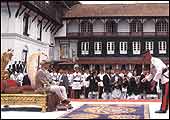| |
COVER STORY:
NEPAL
Throne Of Blood
A canny businessman becomes king but faces
uncertainty over his own future and that of his line of
succession
By Swapan Dasgupta and Farzand Ahmed in Kathmandu
In traditional
societies it is difficult at the best of times to distinguish
between fact and fiction and between history and mythology. In a
Nepal gripped by tension and uncertainty and captivated by the bush
telegraph, the exercise is proving impossible. Consider this quaint
but suggestive tale doing the rounds in curfew-bound
Kathmandu.
When Gyanendra, the present King of Nepal,
was born in July 1947, a court astrologer-and they are legion in
Nepal-told his father, the then Crown Prince Mahendra, to avoid
looking at the newborn because it would bring him bad luck.
Consequently, the baby Gyanendra was dispatched out of Kathmandu to
live with his grandmother in a distant palace. Three years later,
when, exasperated by the high-handedness of his Rana prime minister
King Tribhuvan, with Mahendra and other notable royals in tow, fled
to India, Gyanendra was the only male royal of consequence left in
Nepal. Prime Minister Mohan Shamsher Jang Bahadur Rana brought the
child to Kathmandu and had him crowned king on November 7,
1950.
The first reign of King Gyanendra lasted a
little over three months, with India ensuring King Tribhuvan's
return. For the ousted Gyanendra there was an unexpected windfall.
It seems that coins were struck in those three months with his image
and they became collector's items. The adult Gyanendra, or so the
story goes, made a tidy sum collecting and selling those coins to
numismatists.
 |
|
I, KING: The coronation of
Gyanendra |
For the 53-year-old Gyanendra who was
crowned king for the second time in very unusual circumstances on
June 4, it has been a tussle between irony and destiny. If it was
Mohan Shamsher Jang Bahadur Rana who ensured his first coronation,
it was the shadow of that Rana's great grand-daughter, Devyani, that
hung over his second shy at kingship (see accompanying story). It
was, they say in Nepal, the Rana's ultimate revenge.
Not that King Gyanendra can escape the
opprobrium of history's retribution. Conspiracy being a staple of
the uninformed classes, the 13th ruler of the Shah dynasty cannot
escape the downside of destiny. Why, they ask on the streets, was
Gyanendra conveniently absent from that fateful Friday dinner? Why,
they ask, did the trigger happy Dipendra not bring Gyanendra's son
into his range? How did Queen Komal escape with a single bullet
wound despite being in the room? What others would have called fate,
the sloganeering classes of Nepal call inexplicable. King Birendra's
line became extinct on June 1; King Gyanendra's survived intact. The
first time, James Bond used to say, is an accident, the second time
a coincidence, but the third time is a conspiracy.
It is this uncanny knack for being in the
right place at the right time that has come to dog King Gyanendra. A
man who is by common consent both shrewd and highly intelligent, the
new King's priority is to restore faith and trust in the
monarchy-the institution that has held Nepal together for two
centuries. "Any crack in this institution will weaken both the
country and democracy," says former external affairs minister and
Rashtriya Prajatantra Party (RPP) spokesman Kamal Thapa.
|
|

